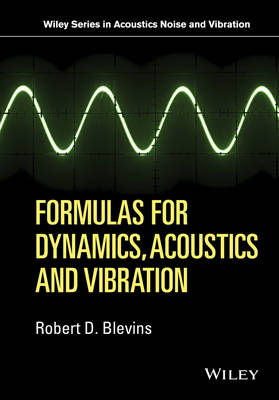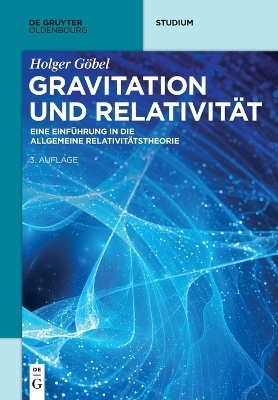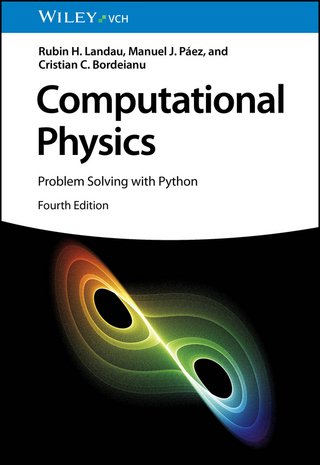
Formulas for Dynamics, Acoustics and Vibration
John Wiley & Sons Inc (Verlag)
978-1-119-03811-5 (ISBN)
Robert D. Blevins is a Fellow at United Technologies. He directs experimental and analytical investigation of dynamics, acoustic, vibration certification issues for commercial aircraft engine systems. Previously he participated in design of nuclear power plants. He has performed flow-induced vibration analysis and test of aircraft, off shore platforms, and vibration of heat exchangers at refineries, nuclear power plants and chemical process plants. He has taught the Flow-induced Vibration Seminar for the ASME for the past 20 years. He received his Ph.D and MS from the California Institute of Technology and serves the ASME special working from on dynamic analysis on the ASME Boiler and Pressure Vessel Code. He has over 50 published papers.
Preface xi
1 Definitions, Units, and Geometric Properties 1
1.1 Definitions 1
1.2 Symbols 8
1.3 Units 11
1.4 Motion on the Surface of the Earth 18
1.5 Geometric Properties of Plane Areas 19
1.6 Geometric Properties of Rigid Bodies 30
1.7 Geometric Properties Defined by Vectors 40
References 41
2 Dynamics of Particles and Bodies 43
2.1 Kinematics and Coordinate Transformations 43
2.2 Newton’s Law of Particle Dynamics 50
2.2.1 Constant Mass Systems 50
2.2.2 Variable Mass Systems 57
2.2.3 Particle Trajectories 58
2.2.4 Work and Energy 63
2.2.5 Impulse 65
2.2.6 Armor 68
2.2.7 Gravitation and Orbits 71
2.3 Rigid Body Rotation 73
2.3.1 Rigid Body Rotation Theory 73
2.3.2 Single-Axis Rotation 73
2.3.3 Multiple-Axis Rotation 84
2.3.4 Gyroscopic Effects 85
References 87
3 Natural Frequency of Spring–Mass Systems, Pendulums, Strings, and Membranes 89
3.1 Harmonic Motion 89
3.2 Spring Constants 91
3.3 Natural Frequencies of Spring–Mass Systems 99
3.3.1 Single-Degree-of-Freedom 99
3.3.2 Two-Degree-of-Freedom System 113
3.4 Modeling Discrete Systems with Springs and Masses 117
3.4.1 Springs with Mass 117
3.4.2 Bellows 118
3.5 Pendulum Natural Frequencies 119
3.5.1 Mass Properties from Frequency Measurement 120
3.6 Tensioned Strings, Cables, and Chain Natural Frequencies 121
3.6.1 Equation of Motion 121
3.6.2 Cable Sag 123
3.7 Membrane Natural Frequencies 126
3.7.1 Flat Membranes 126
3.7.2 Curved Membranes 131
References 132
4 Natural Frequency of Beams 134
4.1 Beam Bending Theory 134
4.1.1 Stress, Strain, and Deformation 134
4.1.2 Sandwich Beams 136
4.1.3 Beam Equation of Motion 137
4.1.4 Boundary Conditions and Modal Solution 137
4.1.5 Beams on Elastic Foundations 141
4.1.6 Simplification for Tubes 141
4.2 Natural Frequencies and Mode Shapes of Single-Span and Multiple-Span Beams 142
4.2.1 Single-Span Beams 142
4.2.2 Orthogonality, Normalization, and Maximum Values 150
4.2.3 Beams Stress 150
4.2.4 Two-Span Beams 151
4.2.5 Multispan Beams 151
4.3 Axially Loaded Beam Natural Frequency 158
4.3.1 Uniform Axial Load 158
4.3.2 Linearly Varying Axial Load 159
4.4 Beams with Masses, Tapered Beams, Beams with Spring Supports, and Shear Beams 162
4.4.1 Beams with Masses 162
4.4.2 Tapered and Stepped Beams 162
4.4.3 Spring-Supported Beams 167
4.4.4 Shear Beams 167
4.4.5 Effect of Shearing Force on the Deflections of Beams 170
4.4.6 Rotary Inertia 170
4.4.7 Multistory Buildings 174
4.5 Torsional and Longitudinal Beam Natural Frequencies 176
4.5.1 Longitudinal Vibration of Beams and Springs 176
4.5.2 Torsional Vibration of Beams and Shafts 179
4.5.3 Circular Cross Section 179
4.5.4 Noncircular Cross Sections 182
4.6 Wave Propagation in Beams 183
4.7 Curved Beams, Rings, and Frames 184
4.7.1 Complete Rings 184
4.7.2 Stress and Strain of Arcs 189
4.7.3 Supported Rings and Helices 190
4.7.4 Circular Arcs, Arches, and Bends 190
4.7.5 Lowest Frequency In-Plane Natural Frequency of an Arc 196
4.7.6 Shallow Arc 197
4.7.7 Portal Frames 198
References 199
5 Natural Frequency of Plates and Shells 203
5.1 Plate Flexure Theory 203
5.1.1 Stress and Strain 203
5.1.2 Boundary Conditions 203
5.1.3 Plate Equation of Motion 205
5.1.4 Simply Supported Rectangular Plate 206
5.1.5 Plates on Elastic Foundations 207
5.1.6 Sandwich Plates 207
5.1.7 Thick Plates and Shear Deformation 207
5.1.8 Membrane Analogy and In-Plane Loads 208
5.1.9 Orthogonality 208
5.2 Plate Natural Frequencies and Mode Shapes 209
5.2.1 Plate Natural Frequencies 209
5.2.2 Circular and Annular Plates 209
5.2.3 Sectorial and Circular Orthotropic Plates 214
5.2.4 Rectangular Plates 214
5.2.5 Parallelogram, Triangular and Point-Supported Plates 215
5.2.6 Rectangular Orthotropic Plates and Grillages 215
5.2.7 Stiffened Plates 231
5.2.8 Perforated Plates 232
5.3 Cylindrical Shells 234
5.3.1 Donnell Thin Shell Theory 235
5.3.2 Natural Frequencies of Cylindrical Shells 237
5.3.3 Infinitely Long Cylindrical Shell Modes (j = 0) 241
5.3.4 Simply Supported Cylindrical Shells without Axial Constraint 243
5.3.5 Cylindrical Shells with Other Boundary Conditions 246
5.3.6 Free–Free Cylindrical Shell 248
5.3.7 Cylindrically Curved Panels 249
5.3.8 Effect of Mean Load on Natural Frequencies 250
5.4 Spherical and Conical Shells 250
5.4.1 Spherical Shells 250
5.4.2 Open Shells and Church Bells 252
5.4.3 Shallow Spherical Shells 252
5.4.4 Conical Shells 254
References 254
6 Acoustics and Fluids 260
6.1 Sound Waves and Decibels 260
6.1.1 Speed of Sound 260
6.1.2 Acoustic Wave Equation 264
6.1.3 Decibels and Sound Power Level 276
6.1.4 Standards for Measurement 277
6.1.5 Attenuation and Transmission Loss (TL) 278
6.2 Sound Propagation in Large Spaces 285
6.2.1 Acoustic Wave Propagation 285
6.2.2 Sound Pressure on Rigid Walls 288
6.2.3 Mass Law for Sound Transmission 289
6.3 Acoustic Waves in Ducts and Rooms 289
6.3.1 Acoustic Waves in Ducts 289
6.3.2 Mufflers and Resonators 298
6.3.3 Room Acoustics 302
6.4 Acoustic Natural Frequencies and Mode Shapes 305
6.4.1 Structure-Acoustic Analogy 306
6.5 Free Surface Waves and Liquid Sloshing 310
6.6 Ships and Floating Systems 319
6.6.1 Ship Natural Frequencies (1/Period) 319
6.7 Added Mass of Structure in Fluids 321
6.7.1 Added Mass Potential Flow Theory 328
6.7.2 Added Mass 329
6.7.3 Added Mass of Plates and Shells 330
References 331
Further Reading 335
7 Forced Vibration 336
7.1 Steady-State Forced Vibration 336
7.1.1 Single-Degree-of-Freedom Spring–Mass Response 336
7.1.2 Multiple-Degree-of-Freedom Spring–Mass System Response 344
7.1.3 Forced Harmonic Vibration of Continuous Systems 347
7.1.4 General System Response 357
7.2 Transient Vibration 359
7.2.1 Transient Vibration Theory 359
7.2.2 Continuous Systems and Initial Conditions 365
7.2.3 Maximum Transient Response and Response Spectra 371
7.2.4 Shock Standards and Shock Test Machines 374
7.3 Vibration Isolation 374
7.3.1 Single-Degree-of-Freedom Vibration Isolation 374
7.3.2 Two-Degree-of-Freedom Vibration Isolation 377
7.4 Random Vibration Response to Spectral Loads 379
7.4.1 Power Spectral Density and Fourier Series 380
7.4.2 Complex Fourier Transform and Random Response 381
7.5 Approximate Response Solution 385
7.5.1 Equivalent Static Loads 389
7.5.2 Scaling Mode Shapes to Load 389
References 391
8 Properties of Solids, Liquids, and Gases 392
8.1 Solids 392
8.2 Liquids 402
8.3 Gases 405
8.3.1 Ideal Gas Law 405
References 409
A Approximate Methods for Natural Frequency 410
A. 1 Relationship between Fundamental Natural Frequency and Static Deflection 410
A. 2 Rayleigh Technique 413
A. 3 Dunkerley and Southwell Methods 415
A. 4 Rayleigh–Ritz and Schmidt Approximations 415
A. 5 Galerkin Procedure for Continuous Structures 416
References 417
B Numerical Integration of Newton’s Second Law 418
References 421
C Standard Octaves and Sound Pressure 422
C. 1 Time History and Overall Sound Pressure 422
C. 2 Peaks and Crest 423
C. 3 Spectra and Spectral Density 424
C. 4 Logarithmic Frequency Scales and Musical Tunings 424
C. 5 Human Perception of Sound (Psychological Acoustics) 426
References 427
D Integrals Containing Mode Shapes of Single-Span Beams 429
Reference 429
E Finite Element Programs 435
E. 1 Professional/Commercial Programs 435
E. 2 Open Source /Low-Cost Programs 436
Index 439
| Erscheint lt. Verlag | 11.12.2015 |
|---|---|
| Reihe/Serie | Wiley Series in Acoustics Noise and Vibration |
| Verlagsort | New York |
| Sprache | englisch |
| Maße | 178 x 252 mm |
| Gewicht | 839 g |
| Themenwelt | Naturwissenschaften ► Physik / Astronomie |
| Technik ► Bauwesen | |
| Technik ► Maschinenbau | |
| ISBN-10 | 1-119-03811-1 / 1119038111 |
| ISBN-13 | 978-1-119-03811-5 / 9781119038115 |
| Zustand | Neuware |
| Haben Sie eine Frage zum Produkt? |
aus dem Bereich


